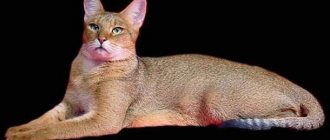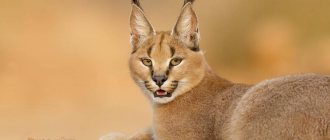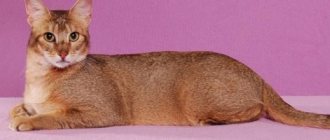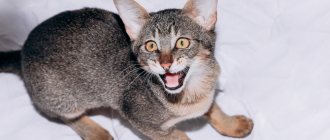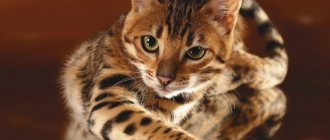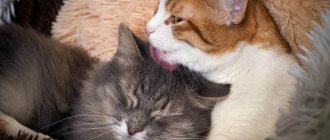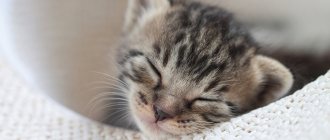The Hausie cat (Chausie) is a hybrid of a domestic and wild animal. Cats differ from their counterparts in appearance and character. The uniqueness of the breed is due to the presence of wild ancestors.
Few breeders are involved in breeding Hausie cats, since the crossing process is labor-intensive and often does not bring the desired result. Keeping animals of this breed is also very troublesome and expensive.
Keeping a jungle cat in captivity
When you decide to get such an exotic pet, keep in mind that the animal has a wild, unbridled temperament that is not easy to cope with. Keeping it at home is a dubious pleasure. As a rule, the animal recognizes only one owner, requiring increased attention. If there is a lack of affection and care, the cat may become offended and even leave the house. During the mating season, the animal is extremely aggressive and dangerous to humans.
When getting this exotic cat, be prepared to spend a lot of time raising it. Keep in mind that it will never be possible to tame an adult, so it is necessary to equip a special enclosure with a height of at least 5 meters and an area of at least 3 meters. If these conditions are not met, the animal’s mobility will be limited, which can lead to illness.
Catching a wild kitten is also not easy; it is better to look for it in a special nursery. An animal up to three months old is relatively easy to tame, but requires more attention. A domesticated cat is extremely active and needs active play and free space. The ideal place to keep it is a country house or cottage. The pet easily gets accustomed to the tray and does not require frequent brushing.
Thanks to good genes, the jungle cat has no hereditary diseases and is in good health. He does not suffer from depression or weak immunity and, with proper care, never gets sick.
Reproduction and care of kittens
The mating season begins in February-March and can last until April. This time passes tensely, with brutal fights between rivals and loud screams. At this time, cats are especially aggressive, so it is better for humans or other animals not to come into contact with them. The conquered female accepts the courtship of the gentleman and begins to prepare for the birth of offspring. The reed lynx finds a suitable place for shelter and insulates it with its own fur.
The offspring are born in May (pregnancy lasts 2 months), and their number is always different - from 2 to 6 individuals, rarely 10 kittens are born at once. In a large litter there are fewer females than males. The kitten's weight is 60-100 g, the cubs are born blind, opening their eyes in the second week of life. The cat feeds them with milk for up to 3 months, and from two months they are gradually accustomed to regular food. The stages of growth are accelerated, while the father does not leave the family and take care of him throughout the entire period of growing up of the kittens. From 5 months they no longer need parental care.
Jungle cat at home
No matter how much you try to dissuade those who want to put a wild creature in their home, it will be of no use. It’s better to talk about how a domestic jungle cat will behave.
Maintaining such an unbridled and active creation of a house will not bring pleasure to people who value their furnishings - everything that was in its place will be chewed, turned over or torn off. For home keeping, it is better to provide the animal with conditions close to natural, for example, organize an enclosure with a pond.
What does a domestic cat (reed cat) do in the house? He gallops as hard as he can around the rooms, rushes like the wind, jumps around the corner onto the owner’s feet, immediately rushing off and disappearing under the closet, as if in a secret lair. To prevent the animal from becoming the absolute master of the house, they begin to educate it from early childhood, simultaneously accustoming it to a scratching post and a tray. To satisfy the natural needs of hunting, you will need to treat the Hausa with live food.
Buy a jungle cat kitten
It is unlikely that anyone will be able to buy a marsh lynx in Russia, since there are no nurseries selling reed kittens here. Of course, you can find an advertisement on some website for the sale of a reed kitten, but is it really such, because you can buy an ordinary yard cat for a fabulous price.
If you have a wild desire to buy a Hausa, then you should not trust illegal sources that are not able to document either the purity of the breed or the state of health of the animal. In addition, when poachers offer an animal from the wild, and not one raised in a nursery in an enclosure, one should not even hope that the cat will become a pet.
The cost of a reed kitten will be no less than 3-8 thousand dollars, so a lower price should alert buyers.
Origin of the breed
Jungle cat or marsh lynx are synonymous names for wild cats. This is a fairly large animal, ranging from 60 to 90 cm in length and weighing from 8 to 12 kg. If you look from the side, you will find that the cat has a short body with long legs. These proportions are necessary for hunting birds in high reeds. The cat's tail is short - from 21 to 30 cm. The color is spotted black-brown or solid brown. There are tassels on the ears.
The species was discovered by traveler Johann Anton Güldenstedt in 1776, when, on the orders of Catherine the Great, he mapped the southern territories of the Russian Empire. Two years later, Johann Christian Schreber included the animal in official documents, gave it its current name and described its appearance in detail.
Important! Jungle cat is the name of a wild breed. It is more correct to call domestic pets a houseie or a chausie.. Distributed quite widely
Found in Western and Minor Asia, Transcaucasia, Central Asia, Hindustan, Indochina and Southwestern China. On Russian territory it can be found on the plains of Dagestan and on the shores of the Caspian Sea and in the lower reaches of the Volga. However, due to hunting and poaching, the jungle cat is now becoming less and less common. The last time it was seen in the wild in Russia was in 1985, back under Soviet rule.
Quite widely distributed. Found in Western and Minor Asia, Transcaucasia, Central Asia, Hindustan, Indochina and Southwestern China. On Russian territory it can be found on the plains of Dagestan and on the shores of the Caspian Sea and in the lower reaches of the Volga. However, due to hunting and poaching, the jungle cat is now becoming less and less common. The last time it was seen in the wild in Russia was in 1985, back under Soviet rule.
Important! The jungle cat is in the Red Book of Russia. Hunting is prohibited. Swamp lynxes love to settle in dense reed and reed thickets near rivers, swamps, lakes and seas
These animals are excellent swimmers. Cats rarely go out into open spaces, but sometimes they can be found near their habitats. In the mountains, cats were found at altitudes of no more than 800 meters. More often, the jungle cat leaves its usual habitats in winter and spring, during periods of food shortage
Swamp lynxes love to settle in dense reed and reed thickets near rivers, swamps, lakes and seas. These animals are excellent swimmers. Cats rarely go out into open spaces, but sometimes they can be found near their habitats. In the mountains, cats were found at altitudes of no more than 800 meters. More often, the jungle cat leaves its usual habitats in winter and spring, during periods of food shortage.
The mating period begins in February and ends in March. At this time, cats can be heard over long distances due to their loud cry. During this period, males can pose a threat to people, as they are large enough to kill or severely injure an unarmed person. Females carry their cubs for 66 days. In May, from 2 to 5 kittens are born. They become sexually mature after 1.5 years.
Important! It was when the swamp lynx was crossed with Abyssinian cats that a new breed appeared - the Hausie.
A new type of domestic cat was first obtained in 1960 and registered in 1995. The breed has the appearance and strength of a wild ancestor, but at the same time it is docile and able to get along with people, although it has a wayward character. Cats have a large body and ears with tassels. They are very strong, capable of jumping high and hunting. But at the same time, they have a friendly character and love to communicate with people.
Exterior
Houses got their exterior from jungle cats:
The coat is short. In summer the coat is loose and coarse, in winter it becomes dense and dense.
The color is black, brown, sometimes slightly silver, usually tecked. Often pets turn out to be multi-colored with brown and black stripes or spots. The coloring greatly depends on what subspecies of the jungle cat is the pet’s ancestor. In southern Asian regions they are brownish-red in color, while in Central Asia and Africa animals with a dirty yellow tint predominate.
Body. These pets are very large, males weigh up to 15 kg, females - up to 10 kg. The height at the withers is about half a meter. They live long - up to 15 years.
Head
An important feature is the tufts on the ears, which is why the pets resemble a lynx. Has excellent hearing and night vision
The sense of smell is poorly developed.
Other characteristics. The tail is of medium length, rather thick. The paws are high, with well-developed muscles, very strong.
Character
Behavior, activity and attitude towards people are very different between wild and domestic representatives of the breed.
Wild swamp lynx
Description and breed standard
These cats definitely cannot be confused with other animals. Housei are large and muscular, the average weight of representatives of this family is 10-15 kg. They grow up to the age of three.
Males are noticeably larger than cats. The Chausie breed has its own calling card - representatives of the F1 generation have tufts on their ears. This external feature was inherited by the animals from their wild ancestors. Tassels can be exclusively black.
Description of the Chausie breed:
- small muzzle with an elongated nose and pronounced cheekbones;
- erect large ears;
- muscular paws, which Housie cats also received from their wild ancestors;
- eyes slightly slanted, ideally amber or green-yellow;
- large neat body, powerful short neck;
- strong legs, with the hind legs longer and stronger;
- the tail is small, given the size of the animal, but not less than 3/4 of the body length.
The jungle cat is most similar in appearance to Chausie cats. The Shawsie or Hausie is only slightly inferior to its wild counterparts in weight and height.
It is also worth considering that the patterns on the body of Chausie cats can be blurry and resemble water ripples. The designs on the paws, tail and head must be clear. Often, in their bizarre shape, the pictures on wool resemble necklaces.
Coat and colors
Chausie cats have short and elastic hair. In healthy animals it should be very thick and shiny. The coat of these cats is inherited from the swamp lynxes living in the wild, so it provides protection against harsh weather conditions.
Coloring can include up to 5 different shades. But according to the standard, no more than 3 are allowed:
- black color;
- ticked tabby (grizzly color);
- silver ticked color.
Representatives of litters from F1 to F3 can boast of these colors. If an animal has predominant domestic cat genes, its coat may be a different shade. But such pets are not allowed to show and are not considered purebred representatives of the breed.
The tip of the tail and ear tufts should be black. This distinctive feature of Chausie F1.
Another distinctive feature of Hausie cats is the “necklace” on their neck. Preferred representatives of the breed have small dark spots on their ears. Dark patterns may also be present on the head and tail. Each hair of the animal is colored in two shades at once, but this cannot be seen with the naked eye.
Character and behavior
In the wild, the jungle cat is an active nocturnal predator. Thanks to his keen eyesight, excellent hearing and ability to swim, he succeeds in every hunt.
It hunts small animals and rodents at night. In winter, he also makes leisurely daytime forays into the thickets. It can also hunt birds - the cat jumps quite high.
Best articles: Cell reproduction by binary fission
By nature, the reed cat is a cautious and secretive solitary animal. He has a mate only during the mating season
Each male has a territory with a radius of 50 to 200 m. Therefore, a domestic jungle cat living in summer cottages poses a threat to all pets in the area (even dogs).
Coping with the temperament of a jungle cat is not easy. He needs active communication with his owner and freedom of movement. Otherwise, the pet will lose interest in life and go wild.
What is typical for a jungle cat:
Mobility. “Movement is life” - this saying fits house perfectly. Even adult cats behave like kittens: they love to play, jump, climb and hunt. The jungle cat is not used to sitting in a person's arms.
Need for affection
In order for a Hausa to have a good disposition and good mood, it is necessary to pay attention to it. Otherwise, he will quickly remember the instincts of his ancestors and may begin to misbehave
The cat will respond to its owner with kindness and tenderness to regular affection and care.
Curiosity. Any sound, even the most mundane (phone ringing, rustling of leaves, etc.), will not go unnoticed by the jungle cat.
Tendency to learn. House is a very smart cat, he quickly learns to open unlocked doors, he is easy to train to the litter box, etc. Also, he is very obedient - he instantly responds to his owner’s commands.
Love for water. He has a positive attitude towards water procedures. Moreover, he will happily swim in a pool, pond or lake.
Amenability. He treats other pets calmly and is not jealous, but only if he receives enough attention.
What and how to feed in captivity
The jungle cat eats once a day, and the diet consists of 200 grams of lean meat (mainly beef), 1 live rat or 2 mice). Live food can be day-old chicks or quails. You can give your cat fresh fish once a week. An important detail of the diet is fasting days, during which the predator fasts for the whole day. Your pet should be unloaded no more than once a week. Such strict measures are needed to save the animal from excess weight. To maintain your pet's health, follow these rules:
- Feed kittens up to a year 2 times a day, after a year - 1 time;
- be sure to supplement the animal’s menu with vitamins, mineral mixtures, and fresh herbs;
- do not refuse to feed plant foods or live food;
- Give your cat a fasting day once every 7-10 days.
What to feed your pet?
House is very unpretentious in food . Kittens need to be fed twice a day, but an adult pet only needs one feeding. He is a hunter, so he needs suitable food. For example, mice or rats are suitable. Two or three mice or one rat per day will be enough.
Find out more about the benefits of dry cat food Hills, Kitekat, Royal Canin.
The diet requires meat and vegetables. The latter need to be boiled. You can give raw fish. Some owners say that the jungle cat happily eats dry food. It should be given according to the instructions on the package, based on the weight and mobility of the animal. One day a week the Hausu does not need to be given food. This is done to prevent obesity.
Life in captivity
The high cost of jungle cats and expensive maintenance rarely deter those who have decided to buy an exotic predator. However, without knowledge of the characteristics of the animal’s character and in the absence of a willingness to devote your free time to its upbringing, it is not worth it.
An adult wild reed cat will not get along at home; it will never be possible to tame it. Such an animal will be more comfortable in a specially equipped enclosure. The area of the cell cannot be less than three square meters, and its height cannot be less than five. Otherwise, the predator’s mobility will be limited and it will begin to get sick.
The enclosure is fenced with a metal mesh. The floor is poured with concrete, wooden flooring is laid on top or sprinkled with earth and sand. If possible, areas are developed for sowing herbaceous plants in order to create conditions as close as possible to the natural habitat. The cage is equipped with a doghouse-type shelter, with straw placed at the bottom, and stone or wooden terraces. Reed cats use trays with fillers as a toilet.
Kittens taken home at three months of age are relatively easy to tame, but require increased attention. From photos of domestic jungle cats, the cubs are difficult to distinguish from ordinary kittens. In reality, they are not as harmless as they seem at first glance. The animals are distinguished by their wayward character, they recognize only one owner and follow him literally on his heels. They are wary of other household members and may snort and hiss loudly at them.
Domestic jungle cats are very active and need active play and open space. There is no better habitat for them than a country house. Animals love affection and walks with their owner in the fresh air. They get accustomed to the tray well and do not require frequent brushing.
The jungle cat feeds once a day. The diet consists of 200 grams of lean meat (most often beef), two live mice or one rat. Live food can also be day-old quails and chickens. Once a week the pet is given fresh fish. An important component of the diet is fasting days (the predator fasts all day long). They are used no more than once a week. Such strict measures are vital and save the animal from excess weight. Mandatory supplements include vitamins for cats, mineral mixtures with calcium, and fresh herbs.
Feeding
In nature, Hausas do not eat porridge. Therefore, you should not offer them a cereal menu at home. But live food, no matter how humane it may be, will have to be fed to the jungle cat every day. After all, what does a jungle cat ideally eat? That's right, game.
The traditional daily diet of an ex-savage looks like this: 200 grams of lean meat plus a couple of live mice (or one rat). As an alternative, high quality Orijen cat food (link to the official website).
Who is a jungle cat
The resident of the reed thickets has several other names:
- swamp lynx;
- house;
- Nile cat.
History of the origin of the reed cat
An amazing feature of the reed cat is that it is not at all afraid of water. Moreover, the animal swims well and catches fish, lowering its head under water and grabbing prey with its teeth.
The inhabitants of Ancient Egypt drew attention to this unusual fact more than three thousand years ago. They tamed the cat and began using it to hunt ducks
In the tombs of the pharaohs, mummies of a jungle cat were found, and ancient frescoes and parchments preserved the image of a Nile cat carrying shot game to its owner.
Ancient Egyptian frescoes contain evidence that reed cats participated in joint hunting with the inhabitants of Ancient Egypt
In addition, the Egyptians took a wild cat to live in their house, thanks to which the animal received another name - “house”, which translates as “house”. Only the brave Egyptians managed to tame an animal with a wild and indomitable character. The rest considered the reed lynx dangerous and tried to keep their distance.
Previously, the reed cat lived in about 25 countries. But hunters began to exterminate the predator and use its skin for farming. In the villages, the swamp lynx was not liked for its attacks on domestic animals. In winter, due to a decrease in the food supply, attacks by the reed cat on chickens and pheasants became commonplace. For this, villagers caught and exterminated the Nile cat.
In 1776, Catherine II sent an expedition to explore southern Russia. While studying the Caucasian nature, scientists discovered an unknown predator. The first to describe this species in his notes was the German naturalist Johann Anton Güldenstedt, who was in the service of the Russian government. But another German turned out to be more successful - Johann Schreber, who in 1778 identified the type of animal. It is Schreber's name that is immortalized opposite the Caucasian type of Hausa.
In 1777, breeders developed a new breed - a hybrid of a swamp lynx and a domestic cat, with a more friendly character. At the end of the twentieth century in the United States, modern housi (chausie) appeared through selection, inheriting the appearance of the wild ancestor and the ability to get along with humans, inherited from the mother.
Juniper cat population
Due to the secluded life that these animals lead, the complete picture of the reed cat population is not entirely clear. The species is critically endangered in many habitats, especially in southeast and southwest Asia. All bog lynxes are listed in the second CITES appendix. A ban on the trade and destruction of animals has been imposed in some states of India and Afghanistan.
The Caucasian subspecies lives in Russia, which is found in:
- Chechnya;
- Ossetia;
- Ingushetia;
- on the coast of the Caspian Sea;
- in the Volga delta.
True, the jungle cat was last seen on the shores of the Caspian Sea in the late 80s of the last century. However, according to the indigenous people, they sometimes encounter the swamp lynx. The Caucasian population is listed in the Red Book of Russia with the status of endangered. According to the information contained in this document, about 500 representatives of this species live in Russia.
The animal is on the verge of extinction for a number of reasons:
- poaching;
- deliberate destruction of an animal for theft of game birds and nutria;
- cold winters;
- drainage of swampy areas;
- weakening of the food supply;
- stronger rivals: leopards;
- wolves;
- wild dogs.
Best articles: What regions is Australia and Oceania divided into - names, countries and characteristics
disturbance of the ecological balance.
The reed cat is kept and bred in separate zoos in our country.
Table: classification of marsh lynx
| Parameter name | Meaning |
| View | Reed cat |
| Genus | Cats |
| Author | Gueldenstaedt, 1776 |
| Family | Felines |
| Class | Mammals |
| Squad | Predatory |
| Type | Chordata |
| Kingdom | Animals |
| Domain | Eukaryotes |
| Lifespan | 10–14 years |
History of the breed
There are written records that jungle cats were known to man more than three thousand years ago.
They depict a house carrying a caught duck out of the water. The ancient Egyptians tamed him, he lived in their houses and helped in hunting. Therefore, it is also called the Nile cat.
He is an excellent bird catcher and swimmer, so the Egyptians took advantage of this quality. They were subsequently replaced by other pets, most likely due to the waywardness of the Hausa. Unfortunately, nowhere except Egypt, and they lived in almost thirty countries of the world, jungle cats did not take root.
Sometimes, especially when there was a shortage of food, they came close to human habitation. Hunters by nature, they destroyed poultry and other small animals. Because of this, they were mercilessly shot. Haus skins have always been in high demand due to their thin skin and warm fur.
As a result, on the coast of the Caspian Sea, in its natural habitat, it was last seen in the late 80s of the last century. Due to the destruction of habitats, the population is becoming smaller, so the jungle cat is a rare species and is listed in the Red Book. She became the progenitor of several breeds of domestic cats.
It was first selected by Americans at the end of the eighteenth century, when the first jungle cat hybrid was bred. They are also the world leaders in its selection. The most famous recognized breed, the so-called domestic jungle cat, is called the Hausie or Chausie. Hybrids of the stone cougar and jungle curl are also known.
Cat house, or swamp lynx
House (or chaus), swamp lynx, jungle cat - different names for one animal, very ancient, original and interesting. He has a lot in common with a person - both good and, unfortunately, tragic.
The jungle cat is a long-time neighbor of man
History of the species
This intelligent, strong animal attracted the close attention of the ancient Egyptians, famous connoisseurs of feline nature, several thousand years ago. They domesticated, as far as possible, the local African subspecies Felis chaus, and since then the proud outline of this animal has been preserved in the famous cat figurines from Ancient Egypt
You recognize - yes, it’s him, cat house
Active attempts to hybridize the marsh lynx began much later, from the end of the eighteenth century - felinologists were looking for options for home keeping that would successfully combine the best qualities of the jungle cat with at least a more or less docile character.
Habitat
A wide strip of the habitat of the jungle cat runs from North Africa through the entire south of Eurasia, right up to Western China. Nine subspecies of the marsh cat freely settled in these territories, which can differ significantly in both color and size.
Despite all the differences in its subspecies, the house cat always remains smart, brave and moderately brutal
Video: where and how the jungle cat lives
Under guard
Unlike most other wild cats, the jungle cat willingly settles close to humans, but both sides are more likely to lose than to gain from such proximity. The marsh cat is not at all averse to hunting domestic animals and does it very successfully. In response, people declare a brutal war on her.
Man is displacing the Hausa from their permanent habitats
However, it is not only the conflict of food interests that seriously threatens the very existence of this wild cat species. Irreparable damage to livestock is caused by ordinary human economic activities: deforestation, drainage of large floodplain areas. Many animals die in “man-made” steppe and forest fires; For many, an abnormally cold winter turns into a tragedy, when it is impossible to either stay warm or find food.
Fur coats made from jungle cat fur, despite the ban, are widely offered on the Internet
Despite its relatively large habitat, the number of the species is constantly falling. This threatens to disrupt the ecological balance, because in the regions where they live, the marsh lynx copes excellently with the work of a natural orderly and successfully regulates the number of small rodents.
Jungle cat nutrition
Like all representatives of the cat family, the house is an excellent hunter. Help your cat hunt successfully:
muscular body; long limbs, allowing the cat to tirelessly run long distances and easily move along the shore of a reservoir; large ears that act as locators and allow them to detect the slightest rustle; sharp claws and teeth that help get food; excellent jumping ability and agility; ability to camouflage; secrecy and caution; excellent swimming ability.
The diet of the jungle cat is quite varied:
- waterfowl and flying birds: ducks;
- pheasants;
- coots;
- stolen poultry.
- water voles;
- snakes;
- tolai hares;
House can travel long distances, simultaneously destroying bird nests. It looks out for a potential victim from an ambush or hiding in a shelter. It tracks its prey for hours, then catches it in several long leaps, grabs it and strangles it. Often catches birds on takeoff, practically soaring in a vertical jump. He is not at all afraid of snakes and easily deals with them.
The jungle cat is a born fisherman. He loves to fish when the tide is low or dry. Sometimes it hits the water with its paw, imitating the movement of insects. The fish floats up, and the animal grabs it from the water, using its claws like a harpoon. Sometimes it lowers its muzzle into the water and grabs the catch with its teeth. The weight of fish caught by Hausa reaches impressive sizes.
On occasion, it drags away baby mammals. It jumps on the back of fawns or young roe deer and gnaws their throats. In times of famine, it gets close to human settlements and steals domestic animals.
Hunting and food
The predator has excellent hearing thanks to its large ears. The cat's vision is sharp, which helps him navigate well in the dark. At the same time, the swamp lynx cannot boast of a good sense of smell and distinguishes odors much worse than other felines. The jungle cat hunts at any time of the day, but prefers to get food in the dead of night or at dusk. For prey, as a rule, it goes into impassable thickets of reeds. It looks out for the victim from ambush, slowly and quietly creeping up and attacking it with a sharp jump, then grabs it with its paws and strangles it.
The diet of wild cats is varied: the animal catches fish, small rodents, crustaceans, land and waterfowl, reptiles, and insects. During seasons characterized by low temperatures, it gets close to human settlements and steals their poultry. A jungle cat can destroy bird nests; near rodent burrows, a predator can wait in ambush for its prey for several hours in a row. The predator is not afraid of snakes, dealing with them as quickly as with frogs.
Life in captivity
Many exotic lovers dream of taming an indomitable predatory animal as a pet. Jungle cats, with their wild beauty, amazing grace and contradictory character, make you want to buy them for any money. Before you decide to buy a house, you need to weigh the pros and cons. There are several aspects to consider:
- The marsh lynx is listed in the Red Book of Russia and is under state protection. You need to purchase an animal only from professional breeders and be sure to check for a veterinary passport.
- Keeping a jungle cat requires a significant investment.
- The animal should be provided with conditions similar to those in nature.
- House recognizes only one owner. Ignores other family members or shows aggression towards them.
- A jungle cat may not live up to the owner’s hopes and will forever remain a wild, uncontrollable animal.
Do not forget that in nature the territory of each individual is several hundred square kilometers. Therefore, it is advisable to keep a cat not in an apartment, but in a country house, where there is plenty of space for a mobile animal. It is better to build a large indoor enclosure, fenced with a strong metal mesh. The dimensions of the fence must be impressive so that the animal feels comfortable staying in it. The floor can be covered with dry reeds or reeds.
The swamp lynx, which lives in a city apartment, needs to be walked periodically so that the animal receives the required dose of ultraviolet rays. It is advisable from time to time to give the jungle cat the opportunity to swim in a natural body of water.
Jungle cats have very good immunity and excellent health. But to avoid problems, your pet should be vaccinated. For cats kept in apartment conditions, you must purchase:
- a tray corresponding to the size of a large cat;
- special filler;
- large scratching post;
- comb for combing wool;
- toys to entertain an inquisitive animal.
The house gets used to the litter box quickly and does not require constant brushing and bathing. But it needs increased attention, affection and constant joint games. If the owner pays little attention to the obstinate animal, the kitten may get bored and even get sick. The jungle cat is a big owner. He is jealous of the chosen owner of other household members and animals living in the same territory.
Feeding of the swamp lynx living in captivity
First of all, it is worth remembering that the domesticated housefish still remains a predator, so it should eat mainly meat. Certain rules must be followed:
- kittens up to one year old are fed twice a day, adults - once;
- Plant foods should be added to the menu;
- Give the animal special vitamins and minerals.
Daily diet:
- 200 grams of lean meat (chicken loin, beef, veal) and two mice or one rat;
- fish once a week;
- a third of the menu should consist of vegetables.
However, even ideal conditions do not guarantee that at a certain time instincts will not take over. The most dangerous period is the mating season. At this time, the animal becomes aggressive and uncontrollable. As soon as the animal reaches puberty, it needs to be castrated or matched. An Abyssinian or other short-haired cat would be suitable. From this union both common and reed kittens are born. Differences appear by three months.
For those who dream of owning a wild cat from the reed thickets, there is an alternative - Hausie cats. They get along well with humans and have a quite friendly character.
Jungle cats are quite friendly towards other animals
Choosing a kitten
Finding a real jungle kitten is not an easy task. They are bred only in nurseries, of which there are very few. You can also try to buy a kitten at an exhibition of elite breeds. If you finally make up your mind and find a kitten, ask the breeders to show its parents. You must make sure that they are indeed real jungle cats.
The type of pedigree papers that must accompany the kitten will only mean something to you and a certain circle of people who are involved in Houses. This is because the breed is considered wild and is not recognized by any of the clubs and federations. The price of a baby jungle cat is “biting”. It starts at five thousand dollars, but according to other sources, the bill goes into tens of thousands for a real Hausa.
Top articles: Andean cat
Look carefully at the kitten, it should be active and playful. The coat and eyes should look good. Mother and kittens must be well-groomed. By the time you decide to take the baby, he should be treated with helminths and given the necessary vaccinations. As a rule, this is done before three months of age. We must remember that this is a wild animal. You can win over the baby by picking him up as early as possible.
Did you know? Jungle cat kittens are born with stripes that disappear with the onset of puberty: natural camouflage for the period until the animals can fend for themselves.
Home or wild?
Home conditions for a jungle cat can only be a private house , not an apartment. This is a large, very active representative of the cat family and needs space. The enclosure for keeping must be at least five square meters and the same in height.
In addition to providing good living conditions, the jungle cat needs attention and training. Without giving him enough time, you will end up with a wild and uncontrollable animal. If you are not ready for this, it is better not to take a kitten. You should always remember that this is a wild animal, which, of course, feels better in the wild. After all, it actually only gets its name from the cat.
Keeping a Hausa at home is akin to keeping, for example, a lynx at home. The jungle cat looks more like a lynx than our usual pet. Alternatively, you can consider purchasing a Housie kitten. This is a cross between a jungle cat and a domestic cat. It was created so that the hybrid retains the external characteristics of a jungle cat, but has a character like that of a domestic cat.
Important! The jungle cat should not be allowed near children. Their behavior can provoke aggression in him.
History of domestication and appearance
The origin of jungle cats dates back to Egypt. The ancient Egyptians were the first to domesticate these animals and named the jungle cat “Nile cat.” Predators were used to hunt ducks more than 3 thousand years ago.
The Chausie breed, a hybrid of a domestic and a jungle cat, was bred for keeping at home. This breed was registered in 1995.
The size of a wild animal varies depending on its habitat. The body length ranges from 50 cm to 1 m, the tail is small - up to 29 cm, the ear height reaches 8.5 cm. Males have tassels at the ends of their ears.
As a result of natural selection, the jungle or reed cat acquired long legs, which allows it to search for prey in shallow water while remaining dry. The animal quickly overtakes prey in thickets of reeds and reeds, jumps high and can survey the area without being noticed.
Some people confuse the Siberian lynx with the marsh lynx, but these are two different species. The first lives in the northern regions of the Russian Federation, more often found in coniferous forests, but animals have been spotted in forested steppes and even beyond the Arctic Circle.
The color of wild cats also depends on their habitat; they can be gray, brown, or brown. Basically, the coat looks brownish, with a gray or olive tint.
Cats living in North Africa and Central Asia are described as gray in color with an ocher tint. The stripes on an adult animal are almost invisible and differ only on the short tail. Kittens are born completely striped, but after six months the stripes become invisible. A distinctive feature of the breed is the tufts on the ears of males.
Raccoon raccoon: description, character, nuances of keeping at home
Where to buy a reed kitten?
In our open spaces, it is practically impossible to buy a purebred reed cat. At least, we have not found a nursery that deals exclusively with House dogs either in Russia or in Ukraine. But on message boards there are rare requests for the sale of reed kittens. Time will tell how reedy they are.
Couldn't find this breed? We recommend paying attention to the Bengal cat. Things are different in America
Houses are also not widely represented there, but those that are represented are distinguished by genuine purity - American breeders are careful about the line, they only allow mating with the Abyssinian breed or with a simple short-haired cat. But even then, not only Chausie, but also ordinary kittens are born in the litter, and only after three months does it become clear
The situation is different in America. Houses are also not widely represented there, but those that are represented are distinguished by genuine purity - American breeders are careful about the line, they only allow mating with the Abyssinian breed or with a simple short-haired cat. But even then, not only chausie, but also ordinary kittens are born in the litter, and only after three months the hoo from the hoo becomes clear.
Since it is impossible to tame a real adult Hausa cat, it is always only about buying a kitten.
A good-blooded Chausie costs 50,000 hryvnia or about 200,000 rubles. Read more about the breed here.
But the price for a reed specimen on the black market can reach tens of thousands of euros.
About breeding
Breeding the Hausi is a long and labor-intensive process. Even experienced breeders believe that this is exorbitant work. Breeders are of the same opinion - that’s why they are not particularly keen on breeding and keeping these cats, despite the opportunity to get rich.
It is worth considering that all chausie f1 males are sterile. At the same time, Chausie f1 are the most expensive representatives of the breed. Accordingly, their breeding is much more profitable (when compared with chausie f2, f3, and so on).
Kittens must be born in a specially prepared place. Mandatory conditions are dryness and warmth. In the future, babies should feed on mother's milk for as long as possible.
One of the parents must be a jungle cat. Chausie f1 can be crossed with an Abyssinian or domestic smooth-haired cat. In this case, the resulting kittens will belong to the f2 generation.
Any impurities in the blood are unacceptable. Non-purebred Hausie cats can be distinguished by their appearance. The only combination that leads to the appearance of chausie f1 is the marsh lynx and the Abyssinian cat.
Description
The body length of the marsh lynx varies between 70-120 cm, and the height at the withers is 35-38 cm. Weight ranges from 4 to 16 kg. Males are larger and heavier than females. Throughout its entire range, there is significant variation in mass. For example, in western Israel, they weigh 43% more than in eastern India. This is likely due to increased competition between different cat species in the east.
The jungle cat is large, slender, with long legs and elongated, close-set, rounded ears that have characteristic small black tufts at the tips. It has a long, thin muzzle, with distinctive white markings above and below the eyes, as well as dark spots in front of the eyes, near the nose.
Reddish, sandy-brown or yellowish-gray coat color is usually plain, without any spots or patterns. However, the ends of the guard hairs are black and create a mottled appearance. House may also have multiple stripes on his legs. The neck is pale cream, with occasional dark or light stripes, and the belly is lighter than the rest of the body. There are several narrow black rings near the tip of the tail. The marsh lynx's tail is smaller than that of a domestic cat, and occupies about a third of the body length, including the head.
Juveniles, from birth to sexual maturity, have stripes and spots. Adult cats may sometimes retain some of these markings, usually in the form of spots or dark stripes on the front and hind legs.
Based primarily on external morphological differences, marsh lynxes have been divided into 10 subspecies:
- F. c. nilotica (Egypt);
- F. c. chaus (Caucasus);
- F. c. furax (Israel and Iraq);
- F. c. oxiana (along the Syr Darya and Amu Darya rivers);
- F. c. prateri (Thar Desert in the Indo-Pakistan region);
- F. c. affinis (Himalayan region);
- F. c. kutas (Northern India);
- F. c. valballala (South India);
- F. c. kelaarti (Sri Lanka);
- F.c. fulvidina (Southeast Asia).
Description of jungle cats
Where today you can see ten subspecies of the predator in natural habitats, it is in Kashmir, the Caucasus (Caucasian reed cat), Indochina, South India, North India, Pakistan, the Nile River Valley in Egypt and on the island. Sri Lanka.
So, how can you recognize the “same” cat in a wild animal you meet?
Like the lynx, the jungle cat has small tufts at the tips of its ears. The color of the coat is very strongly influenced by the habitat: the main shades of the coat are brown, gray and brown with various combinations. Often a red stripe is visible along the spine. The ears, forehead and back of the head are also reddish, but the groin area and chin are whitish-yellowish. The gray tail has black rings and a tip. Newly born kittens will be completely tabby.
Companions from Central Asia and northern Africa are gray-yellow in color - nature made sure that the predator blends into the landscape. South Asian cats are tan. The first description of the Haus breed was made by the naturalist Johann Anton Güldenstedt in 1776: he saw a large, strong cat with rounded ears with tassels, like a lynx. The animal's muzzle is long, thin, and there are whitish markings near the eyes and dark spots near the nose. An interesting fact is that the tail of wild cats is much shorter than that of an ordinary domestic cat - a third of the length of the entire body and head.
Dimensions and weight of jungle cats
Even at a tender age, jungle kittens are quite large. They are born weighing about 136 g and grow continuously, adding 20-22 g per day.
Wild representatives of the species weigh from 12 to 16 kg, and domestic cats of the reed breed are much smaller: 6-12 kg, which is still larger than the size of the average adult cat. Females weigh less than males and appear less massive. The habitat also affects weight: cats living in western Israel weigh almost half as much as those living in India. Competition among individuals for the right to survive probably plays a role.
The length of these handsome cats reaches 100-120 cm, and their height at the withers is approximately 50-70 cm. Since the animal’s legs are long, strong and strong, if you put an ordinary pet side by side for comparison, the difference will be even more noticeable.
Breed Features
The jungle cat is by nature a wild animal . Maintaining, raising and caring for him at home is quite difficult. He is very different from domestic cats, not only in appearance, but also in character.
Important! The Hausa jungle cat should not be confused with the Hausi breed. The latter was specially bred by crossing a jungle cat and a domestic cat.
Description and photo of the cat
In the wild, cats live in Kazakhstan, Dagestan, Afghanistan, Pakistan, India, Iran, Iraq, Syria, Sri Lanka, Thailand, and Egypt. They can have different colors and sizes. The color of the coat can be from red to brown, gray-brown to black. It was based on their color that they were divided into 10 subspecies . The back and head of the Hausa are darker than the belly and tail, and there are stripes on the legs and tail. The structure of the coat is smooth, short, very thick. In winter, like all animals, it gets even thicker. The head is quite large with large erect triangular ears set high, and the muzzle is elongated.
Adults have tufts on their ears, giving them a lynx-like appearance and giving them the nickname "swamp lynx". Large, almond-shaped eyes, usually green or yellow in color. A distinctive feature of the House is its long, muscular legs. And the tail is short, about a third of the body long, which is about 20-30 centimeters, with a black tip. These are quite large representatives of the cat family. Males, which are an order of magnitude larger than females, can reach a length with a tail of 125 cm, a height at the withers of up to half a meter and weigh up to 15 kg. The smallest jungle cats live in Thailand and Sri Lanka. They can weigh from 4 kg and be from 75 cm in length.
In nature, Hausas live in swampy areas overgrown with reeds, impassable thickets of bushes, and on the outskirts of the forest. They do not like open places and do not climb trees. Swamp lynxes are excellent hunters .
They catch birds, small rodents, gophers, hares and even small wild pigs. They swim very well. In this way they get their own fish and hide from persecution. They prefer to hunt in the dark. This is done less often during the day in cool weather. The house cat meows, but much louder than other cats and as if with a “bass”. In February and early March, jungle cats mate. Males fight for the right to own a female, arranging fights among themselves. A little more than two months later, kittens are born. Usually there are from three to six of them in a litter, but sometimes up to ten. Babies have clearly visible stripes on their fur, which disappear as they grow.
On the tenth day, the kittens' eyes open, they feed on milk for up to three months, and at five they are already completely independent. As a rule, this is where their communication with relatives ends, since cats are loners by nature. Houses live up to 14 years.
Did you know? Native speakers of English call the jungle cat “jungle cat”, as well as “reed cat” (Jungle cat, Reed cat).
Animal character
In two words, the character of a Hausa can be described as follows: it is a cat that walks on its own . He has the temperament of a wild cat and is not aggressive unless touched. Otherwise, troubles cannot be avoided. The owners of real jungle cats said that in fights they caused serious damage to shepherd dogs and mastiffs. At the same time, they get along well with cats. Swamp lynxes are predators by nature, so it is better not to play with them. For the same reason, people who have children should not have them . They are hunters, so all domestic animals such as birds and rodents face an unenviable fate. If such a pet lives in a private house, then there will definitely be no mice, rats, or birds on the territory. Even neighbors' dogs that suddenly run into the territory can be strangled.
We advise you to familiarize yourself with the ten most expensive cat breeds in the world.
